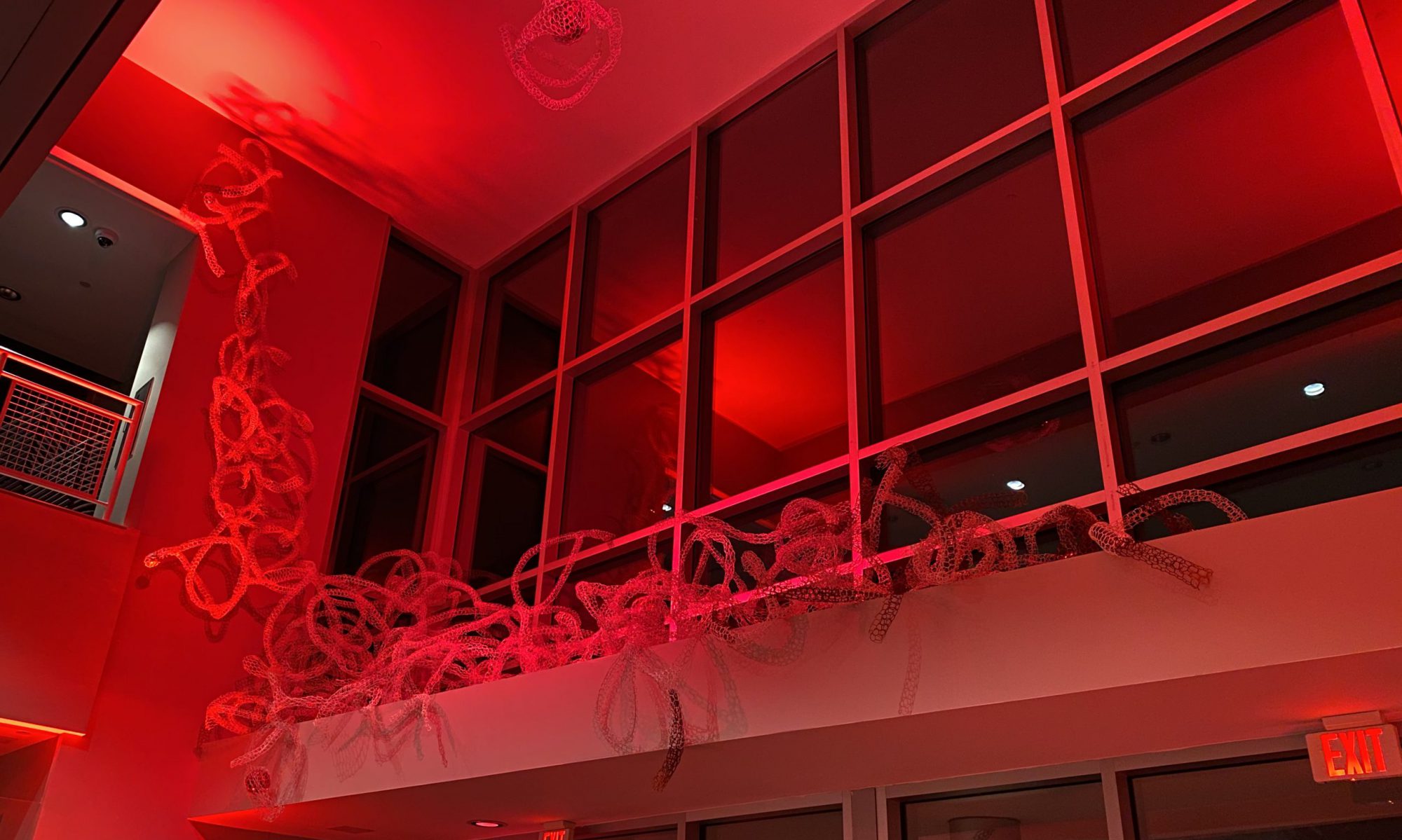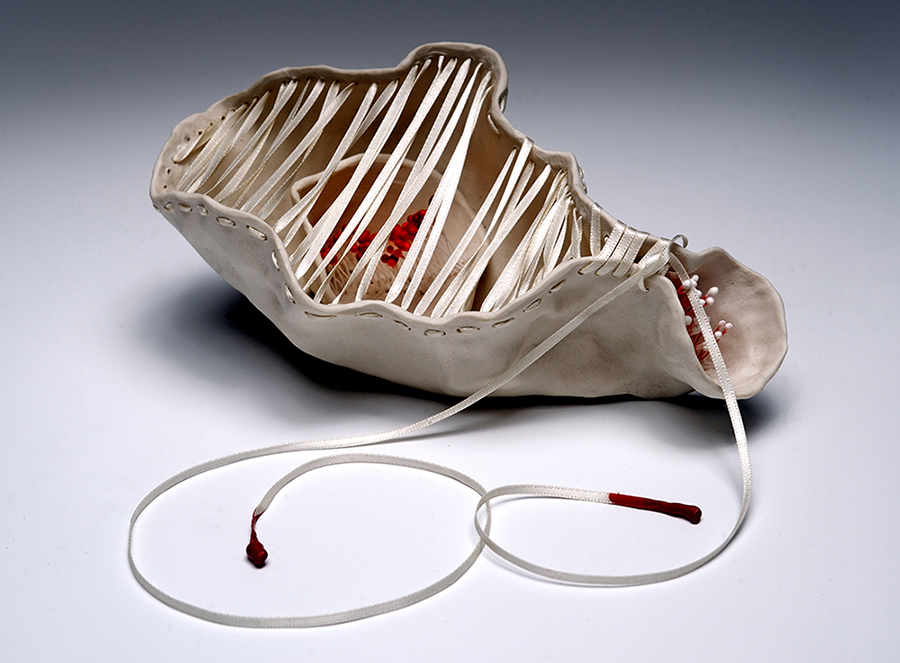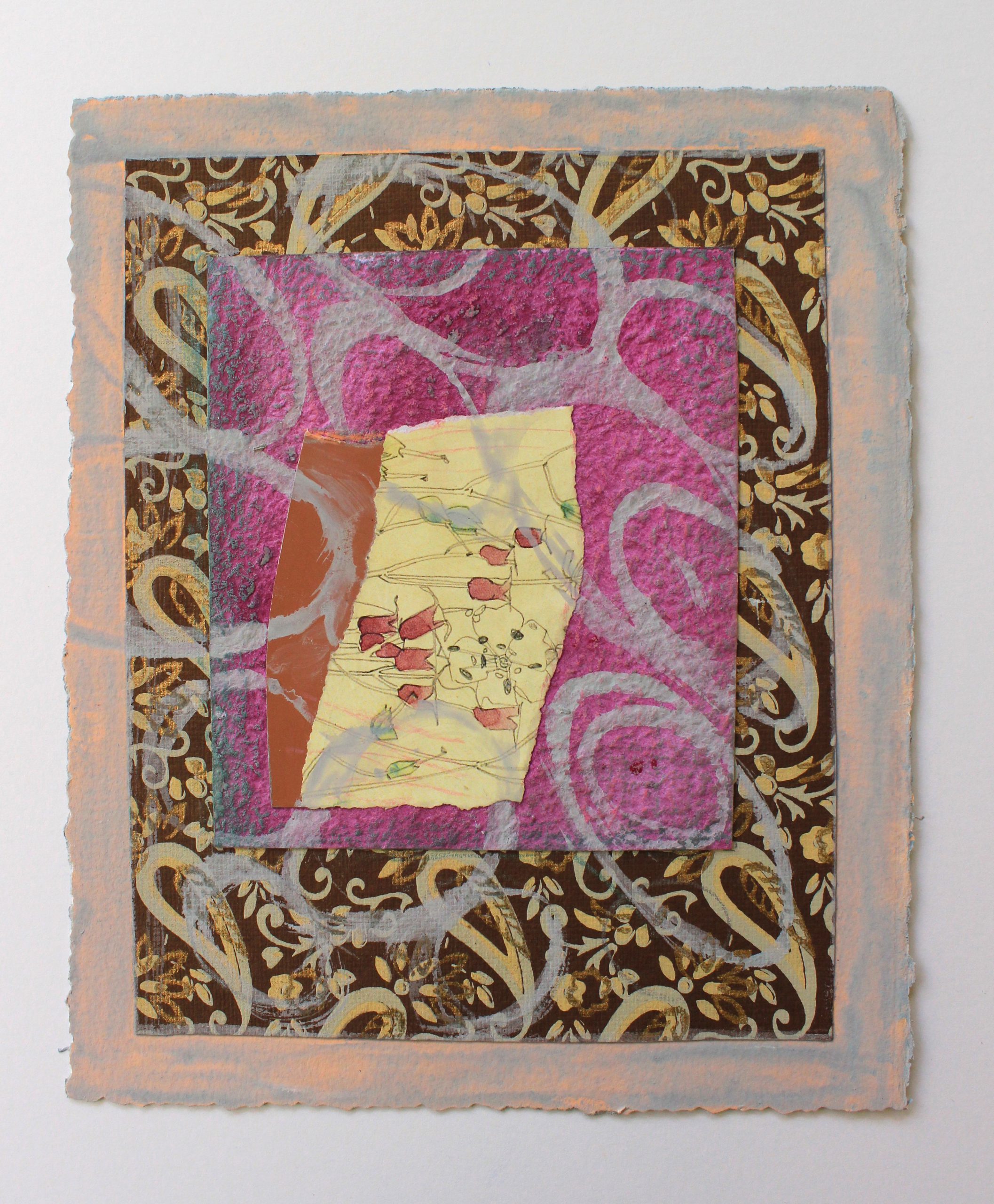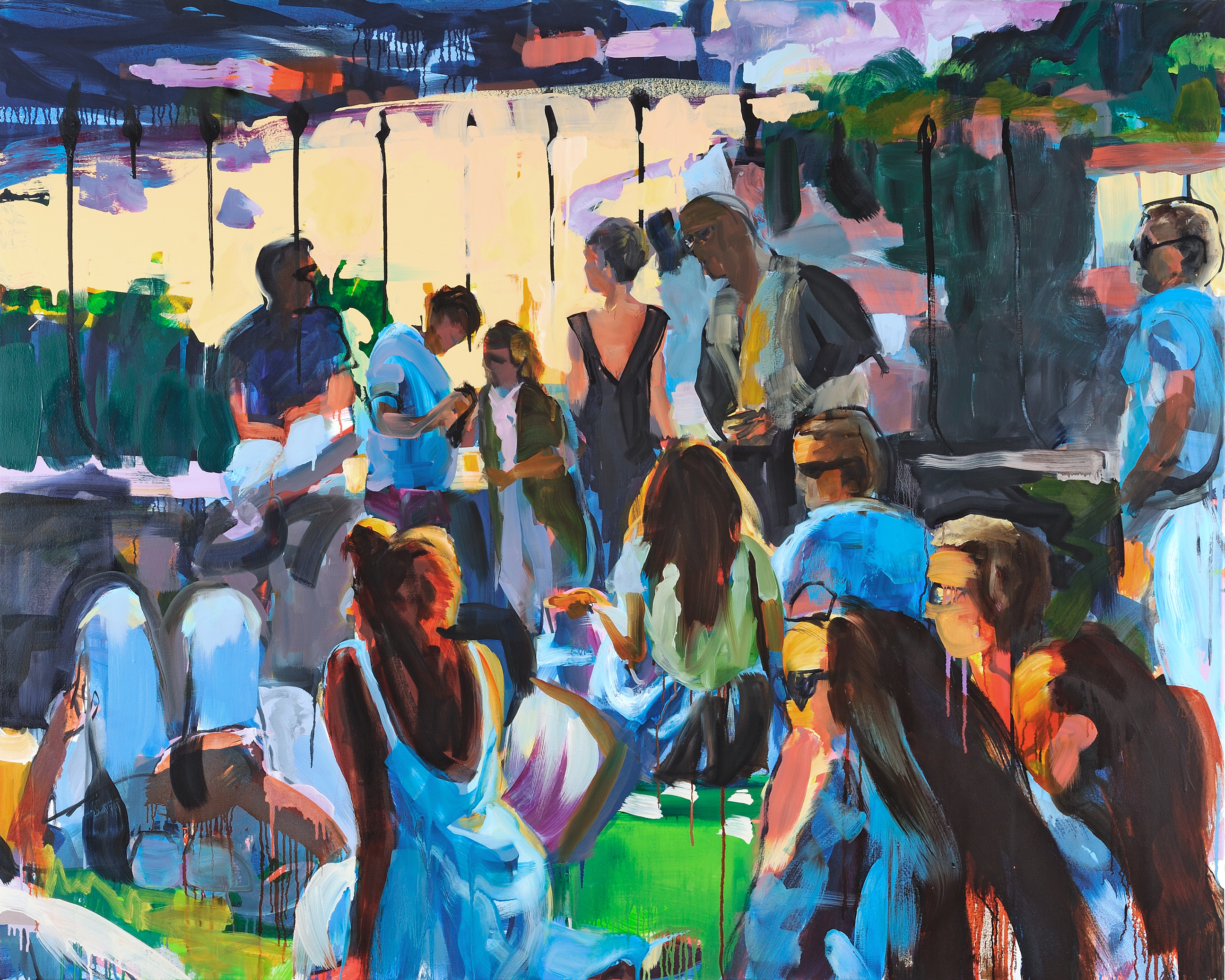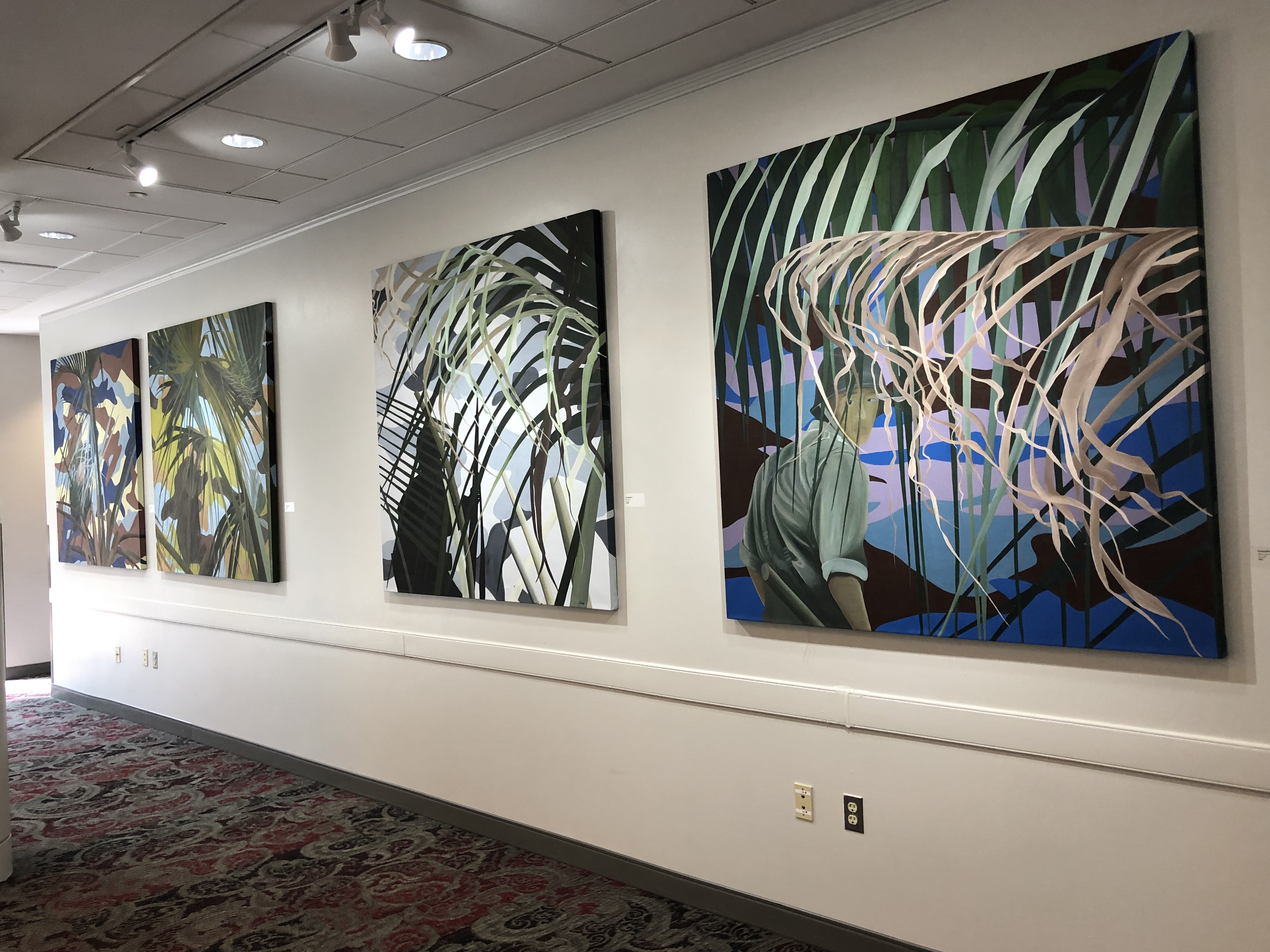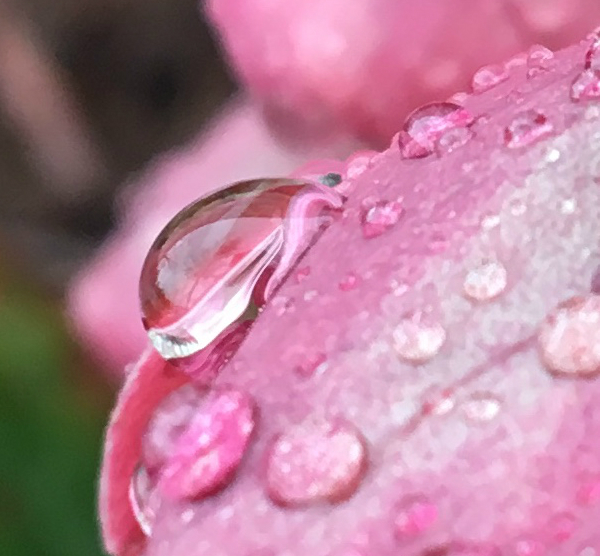Sami Miranda – Sketchbook
Sami Miranda jamming with Pepe Gonzalez, William Knowles, and Mark Merella
Chino Bicicleta Explains His Actions to Spanish Joe
Creative collaboration is integral to Sami Miranda’s art. Please enjoy this video of Sami jamming with Pepe Gonzalez on bass, William Knowles on piano, and Mark Merella on percussion. We also hope that you will visit his online visual art exhibition, We are Always in Conversation: Work by Samuel Miranda.
You can also learn more about Samuel by visiting his website at https://www.samimiranda.com/ and follow him on Instagram at @tres-raices_arts
Email the gallery director, Mary Higgins for inquiries about work in the virtual exhibition.
Online Gallery programs are live!
The Schlesinger and Fisher Art Galleries web programs are live! We have begun an online gallery program. We have started a podcast series – In this Time: Conversations with Artists – that is available on your favorite podcast app as well as on our blog. View the podcast resource pages and visit our first online exhibition We Are Always in Conversation: Works by Samuel Miranda. Join us this Friday on the Fisher Art Gallery Instagram for a Instagram Live poetry reading with Samuel Miranda.
Covid-19 Update – Schlesinger Arts Center – Alexandria Campus
Covid-19 Update
We regretfully announce that all exhibitions have been postponed due to the COVID-19 outbreak. During this crisis, Northern Virginia Community College is following CDC and State of Virginia guidelines and policies.
The Northern Virginia Community College posts updates on the emergency twitch daily on the NVCC COVID-19 page https://www.nvcc.edu/coronavirus/index.html
We wish you good health as you stay at home home during this crisis. Follow the galleries on Instagram @fisherartgallery, Facebook on @fisherartgallery and twitter on @fisherartgallery.
We are planning virtual gallery content during this period of time. We’ll announce on social media . Be Well!
March 7th, 2020 1-3pm Artist Talk with Kirsty Little
February 29, 2020 1-3PM – Artist Talk with Elizabeth Vorlicek
Conduit by Veronica Szalus
January 25, 2020, 2-4PM, Walter Kravitz, Elizabeth Vorlicek, and Kirsty Little
A Conversation with Sally Kauffman
A Conversation with Sally Kauffman
Chill Out: Paintings by Sally Kauffman
Artist Talks: November 20, 2019, 5-7PM
Forum Gallery: Schlesinger Arts Center
Northern Virginia Community College – Alexandria Campus
When did you know that you were an artist?
As a child I would sequester myself in a secret spot and draw for hours.
Was there a particular experience that inspired your decision to pursue art?
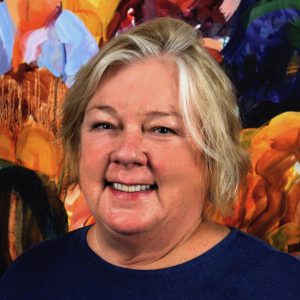 My grandmother taught me to draw and paint as a young girl. One of my favorite memories is sitting by her side watching her paint with watercolors. Her life inspired my own. She was a magical, mystical woman who entertained her family with lavish meals during holidays, especially at Christmas when she dressed as Mrs. Klaus.
My grandmother taught me to draw and paint as a young girl. One of my favorite memories is sitting by her side watching her paint with watercolors. Her life inspired my own. She was a magical, mystical woman who entertained her family with lavish meals during holidays, especially at Christmas when she dressed as Mrs. Klaus.
She owned and operated a therapeutic spa for women as well as an art practice. She painted wonderful images of nature and people. She taught me that I could be whatever I wanted to be.
Are there particular artists or art movements that are an inspiration to you?
Movements and painters amongst the many that influenced my practice from early on include Ukiyo-e artist Hokusai, Venetian School painters Titian, Tintoretto and Veronese, Les Nabis artists Bonnard and Vuillard and Fauvist Matisse. Abstract Expressionism was and remains a major influence. De Kooning, Frankenthaler, Rothko, Pollock, Raushenberg, Johns, Twombly, Mitchell, Krasner, I can’t think of any who did not influence my work. Bay Area Figurative painter Diebenkorn was a revelation to me. Contemporary movements and artists that I currently look at are the YBA (Young British Artists) Cecily Brown, Jenny Saville, Rachel Whiteread and Tracey Emin among many others as well as South African artist Marlene Dumas.
Can you describe your artistic process?
To create the series “Relaxed States” which includes the exhibition “Chill Out”, I discreetly captured images of groups of people lounging and relaxing together using my phone camera. I create digital sketches from the photos by collaging elements and enhancing the color to create a visually dense image. The saturated digital color informs my palette. I mix oil paint and oil painting mediums into a fluid, smooth consistency in small jars, then brush blocks of transparent color directly on the canvas building up multiple layers that afford me flexibility in defining the position and form of the elements. As the forms evolve I respond to the images on the canvas and only reference the digital sketch if I find the need for the original images to inform my own.
Can you talk about how you use visual technologies (computers and software) with your artistic process?
I limit the use of software tools in my creative process to my iPhone and image processing software including Preview, iPhoto and Gimp, all free or shipped with my Mac even though I used many sophisticated tools for 25 years in the tech industry as a user experience designer, graphic designer and art & design director. I’ve resisted integrating digital technology into my art even though I am still fascinated by it, I’m seeking an escape from designing simulated environments and want to live again in the physical world using tangible tools. A good day is when I come home from the studio with paint in my hair and on my face and hands. I use digital tools to create digital sketches in the conceptual phase using snapshots with my iPhone and manipulating the images on the computer. I print the sketches and use them as a reference. The final artwork is produced by hand with paint and canvas.
You have four paintings in the exhibition that were inspired by the summer jazz concerts at the National Gallery in Washington DC. Can you tell us about that experience and what made you want to explore the experience in paint?
 The long answer: after a 20 year hiatus from painting while I worked in the tech industry, I needed inspiration as I resumed my painting practice so I enrolled in a class called “Painting in a Series” at the Corcoran taught by Judy Southerland. Judy reviewed my work and asked me what I was going to paint. I did not know so she gave me a written exercise titled “What Matters” in which you described an activity you care about and how it affects you and others, a social system that interests you and your stance in relation to this system and a condition or question that interests you. I filled it out but still it was unclear to me. So I turned to my private life. My husband and I love to cook and entertain our friends so I started photographing and painting my dinner parties. Out of this grew a series of work centered on groups of people sharing food, swimming and listening to music.
The long answer: after a 20 year hiatus from painting while I worked in the tech industry, I needed inspiration as I resumed my painting practice so I enrolled in a class called “Painting in a Series” at the Corcoran taught by Judy Southerland. Judy reviewed my work and asked me what I was going to paint. I did not know so she gave me a written exercise titled “What Matters” in which you described an activity you care about and how it affects you and others, a social system that interests you and your stance in relation to this system and a condition or question that interests you. I filled it out but still it was unclear to me. So I turned to my private life. My husband and I love to cook and entertain our friends so I started photographing and painting my dinner parties. Out of this grew a series of work centered on groups of people sharing food, swimming and listening to music.
The paintings in the exhibition were inspired by evenings spent sitting in the National Sculpture garden listening to jazz surrounded by the fascinating people who live in DC. I wanted the paintings to celebrate and exude the kind of energy and pleasure that you would find in Manet’s “Le Dejeuner sur l’herbe” and Titian’s painting “The Bacchanal of the Andrians”.
What about your strolls through Porto inspired you? The color and light in the two series of works is very different. How do you use color and light to create the atmosphere in your paintings?
 I visited the Passeio Das Virtudes during the “golden hour” which is the first or last hour of sunlight in a day when the light is soft and warm and the shadows long. This combination of warm colors contrasted with darker cool color defines my typical palette and explains my attraction to the scene.
I visited the Passeio Das Virtudes during the “golden hour” which is the first or last hour of sunlight in a day when the light is soft and warm and the shadows long. This combination of warm colors contrasted with darker cool color defines my typical palette and explains my attraction to the scene.
The paintings inspired from the “Jazz in the Garden” depict the warmer light just before the golden hour. I’m fascinated by paintings that create drama using chiaroscuro, the strong contrast of light or lack of it to define volume in form. Diebenkorn and Hopper’s use of chiaroscuro in their paintings is a good example of this and of course, Caravaggio was the master.
What is that you would like the viewer to take away from their experience of seeing this exhibition?
A collector of a painting in this series recently wrote to me “every time we look at your piece of art we are more delighted.” That is one of the most satisfying aspects of my art practice.
Is there any advice that you would give students as they have made the decision to pursue art?
Define what you want your art practice to be and treat your practice as a profession. This can and will change over time as you mature as an artist and a person. Schedule time for your practice and stick to it even if it involves sitting in your studio and staring at the walls, this is critical to your development. Build a network of your peers by attending local exhibitions and introducing yourself to the artists and gallery owners. Once you have built up that network support your artist friends by attending their art events. Define a social media strategy for yourself. Attend the free lectures at the Smithsonian. Read Art/Work = Everything You Need to Know (and Do) As You Pursue Your Art Career. Rent a studio that hosts open studios and will expose you to other artists and collectors.
To kickstart my art practice after a long hiatus, I studied at the Corcoran in the evenings for 3 years with Judy Southerland who become a mentor for me. (find a mentor) The artists I met in her class are now my peers. I rented studios through which I met different groups of artist friends. I also joined the Studio Gallery, the longest running artist coops in DC, while I had another full-time job. Scheduled annual shows taught me how to prepare and install an exhibit. I learned that I needed to paint when I really didn’t have time or feel like it and how to market my work. I served on the board and learned how to run a gallery. And made more artist friends. I applied for and attended an artist residency at Vermont Studio Center and met an international group of artists. Your network is going to be very important to you. They will expose you to new opportunities and will enrich your practice and life.
What can we expect from your work in the future?
I’m embarking on a big adventure in January. I’m moving to Rome for a year. There are so many things I want to do while I’m there, I’ll be taking workshops, spending lots of time in the museums and galleries and soaking it all in. I’m hoping it will take my work in new directions.
A Conversation with Cathy Abramson
A Conversation with Cathy Abramson
“Dreams of the Underground”
On display in the Margaret W. & Joseph L. Fisher Art Gallery through December 23rd, 2019
Rachel M. Schlesinger Concert Hall and Arts Center
Can you describe your artistic process?
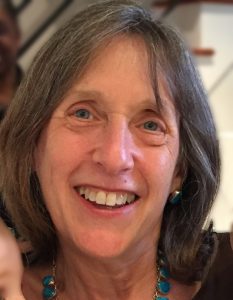 I start by taking photos, lots of photos. I try to carry my camera or iPhone with me and will stop and take a picture if something strikes me as noteworthy, a building in the golden hour, a shadow, people gathered at a public event, a reflection in a window. Often the images won’t make a full composition but have an interesting texture of an element that could be part of a painting. I spend a lot of time thinking about the images I’ve gathered and something will call out to me and then I’ll start composing an image in Photoshop. Frequently this image becomes a small painted color study and if the potential is there for a larger painting, I’ll go ahead and will begin sketching the image in paint on a toned canvas or panel. First I work up a value study and when I’m pleased with the result I add color. I often use squeegees and rollers in addition to my paint brushes to get a desired effect.
I start by taking photos, lots of photos. I try to carry my camera or iPhone with me and will stop and take a picture if something strikes me as noteworthy, a building in the golden hour, a shadow, people gathered at a public event, a reflection in a window. Often the images won’t make a full composition but have an interesting texture of an element that could be part of a painting. I spend a lot of time thinking about the images I’ve gathered and something will call out to me and then I’ll start composing an image in Photoshop. Frequently this image becomes a small painted color study and if the potential is there for a larger painting, I’ll go ahead and will begin sketching the image in paint on a toned canvas or panel. First I work up a value study and when I’m pleased with the result I add color. I often use squeegees and rollers in addition to my paint brushes to get a desired effect.
When did you know that you were in an artist?
I always loved to draw. I never got good grades in art courses but it was just something I loved doing. I needed a job and took illustration and graphic design courses and became an illustrator and art director even though my first degree was in Political Science. One of my first jobs was as an art director at a political magazine and I drew a pretty good Ronald Reagan. One letter to the editor commented on a cartoon I did for the magazine. It said that one of my cartoons was offensive...I knew I was off and running!
When I retired as an art director, I was able to take a 3 year course of master painting techniques at the Compass Atelier in Rockville, get a studio and paint as much as I could. I can now spend a good amount of my time painting.
What are your artistic inspirations? Are there particular artists or art movements that are an inspiration to you?
I’m a representational painter and like the structure of painting something recognizable. I’ve always loved Edward Hopper and my work is often compared to his although I think my paintings are not as lonely and the characters are not as isolated. I’ve always been interested in narrative and looked to illustrators for inspiration. I’ve spent many hours looking at the art of Ben Shahn, Edward Sorel, Ralph Steadman, David Levine, Leonard Baskin and copying their work. As far as painters are concerned, aside from Hopper, there are any number of contemporary painters that I admire: Burton Silverman, Alyssa Monks, Steven Assael, Lucien Freud, any of the California figurative painters.
More recently I’ve been following Alex Kanevsky and David Kassan. Often the last show or artist I’ve seen becomes my new favorite.
Why does the urban environment inspire you over other environments?
I love the activity, interplay of light and shadow, and the sheer mass of architectural forms. Everything is constantly changing in the urban environment and there’s an urgency to really look and see what’s going on. There’s also a need to examine the underlying politics and social interactions and decode what is apparent and what lies just below the surface.
What is it that you hope to capture of your experience in Washington DC and other locations?
Many of my past paintings in the district had to do with neighborhoods and people in transition. Many neighborhoods including the Kennedy Street corridor are being overhauled and there are stories to record and examine. Now I’m interested in the Brutalist buildings in Washington, DC. There’s a gritty beauty in parking garages or the many government buildings that are wall-to-wall slabs of concrete. Believe it or not, even the FBI building has a certain charm. I like to see how people interact with these sterile buildings and think of a narrative for those settings and people.
You have a painting in the exhibition entitled “Cathedral”. What about the subject matter inspired you to call the painting after a type of church?
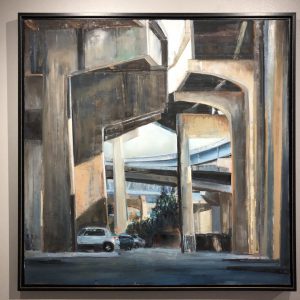
“Cathedral” is an underpass at the beginning of Magazine Street in New Orleans, near the National WWII Museum. I’ve done a number of paintings at this location and there’s the potential for many more. I loved how the light filtered in between the massive highway supports, much like the light filtering through stained glass windows and falling on the columns in a cathedral.
The texture of the concrete and metal are similar to textures found in cathedrals. The parked cars add a human scale to the setting much like the congregants who are dwarfed by the soaring ceilings in a cathedral. The final note is that cars and technology are worshiped in America.
Tell us about the people in your paintings? For example the women that is the subject of “ In her Shadow” or “ Dream of the Underground”
 The woman in “In Her Shadow” is Ms. Vee, Veronica Cooper. She is a force of nature and began her career as one of the first female pullman porters, She has worked as an accountant, seamstress and artist. She owned and operated Culture Coffee on Kennedy Street and opened Culture Coffee Too in Fort Totten a couple of years ago. She is always stylish from her brightly colored glasses to her gold lame pants.
The woman in “In Her Shadow” is Ms. Vee, Veronica Cooper. She is a force of nature and began her career as one of the first female pullman porters, She has worked as an accountant, seamstress and artist. She owned and operated Culture Coffee on Kennedy Street and opened Culture Coffee Too in Fort Totten a couple of years ago. She is always stylish from her brightly colored glasses to her gold lame pants.
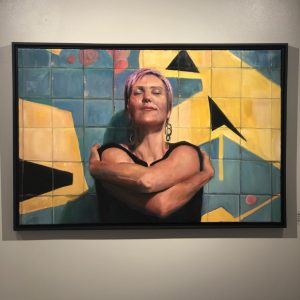
I don’t know much about Sara, the model and dancer in “Dreams of the Underground.” Sara Lavan is the Founder, Executive and Co-Artistic Director of local motion project and was a model the day of a photo shoot and fundraiser that I attended I loved the way she hugged herself and seemed to be wrapped in her own world and dreams. And, what’s not to love about her pink hair.
What is that you would like the viewer to take away from their experience of seeing this exhibition?
I’d like people to come away with a new appreciation for our urban environment, it’s stories and it’s people. Living in a city is a moment to moment experience and I try to isolate a moment, capture it, and move on. These fleeting moments often resonate with the viewer’s own life and narratives. I love to hear the stories the viewers invent on the spot!
Is there any advice that you would give students who have made the decision to pursue art?
It’s very simple, if you love it, do it. Making a living as an artist can be a stretch but you can find a little time here and there for your art. Scale your projects to the time you have available so you don’t get frustrated. If art is important to you make it a priority and expect others to respect your time. Try to schedule time for art just as you schedule time for work, family, friends and all your other interests. Making art can be a joyful, sensual experience and making good art is probably one of the most difficult things you can attempt. The sense of accomplishment you get when you produce something you are proud of is unbeatable.
What can we expect from your work in the future?
I have so many projects and paintings in mind. My next few paintings will be portraits, some personal and some of the women I met while teaching some art classes at a local women’s shelter. I struggle with portraiture and want to get much better. After that it’s back to paintings of DC. I took a number of photos at last year’s Funk Parade and can’t wait to paint from those amazing, colorful images.
November 20, 2019 5-7PM Exhibition Walk Tour Kauffman, Hirons, Abramson
Please join us next Weds evening for a walking tour of our current solo exhibitions with the artist Sally Kauffman, Cathy Abramson and Jean Hirons. They will reach be talking about the work in their solo shows.
CHILL OUT: Paintings by Sally Kauffman

Winter Light: Pastels by Jean Hirons

Dreams of the Underground: Paintings by Cathy Abramson
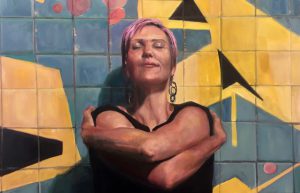
October 19, 2019 2-4PM Art Opening – Sally Kauffman, Jean Hirons, Cathy Abramson and Veronica Szcalus
Please join us on Saturday afternoon October 19, 2019 from 2-4PM for the Final 2019 art openings at the Fisher and Schlesinger Center Art Galleries. We will be celebrating the work of four talented local artists. The artist are Sally Kauffman in the Forum Gallery, Jean Hirons in the Passage Gallery and Cathy Abramson in the Margaret W. & Joseph L. Fisher Art Gallery.
Forum Gallery
Chill Out: Paintings by Sally Kauffman
October 12, 2019 – December 23, 2019
 Kauffman is best known for her abstract yet allusory large-scale paintings that celebrate and exude pleasure. Her gestural brushwork and sensual application of paint reference the figure in landscape. Kauffman draws on personal experiences as a source for her images; Friday Jazz in the Garden concerts at the NGA and recent strolls through Porto provide the setting for the series “Chill Out”. Kauffman captures moments in snapshots and digitally manipulates the composition and intensity of color. The dense, saturated images become the source for the paintings. Almost human scale figures painted in saturated, flowing oil color on large format canvas entice the viewer to engage in their own narrative.
Kauffman is best known for her abstract yet allusory large-scale paintings that celebrate and exude pleasure. Her gestural brushwork and sensual application of paint reference the figure in landscape. Kauffman draws on personal experiences as a source for her images; Friday Jazz in the Garden concerts at the NGA and recent strolls through Porto provide the setting for the series “Chill Out”. Kauffman captures moments in snapshots and digitally manipulates the composition and intensity of color. The dense, saturated images become the source for the paintings. Almost human scale figures painted in saturated, flowing oil color on large format canvas entice the viewer to engage in their own narrative.
Passage Gallery
Winter Light: Pastels by Jean Hirons
October 12, 2019 – December 23, 2019
 Jean Hirons has spent 20 years specializing in the art of soft pastel. Jean’s passion is for the landscape, particularly buildings in the landscape. She began by painting New England houses and rural farms. Since 2015, she has focused on various areas of Washington, DC: Capitol Hill, Georgetown, Chinatown, and Dupont Circle. She finds this subject matter both challenging and satisfying. Composition is always the starting point in any of her paintings and she often looks for abstract shapes. For color, she may use what she sees but, more often, uses color from her imagination. She wants color to be real enough, but not necessarily what was there! Jean also loves complex, broken color and finds pastel to be a perfect medium for achieving this effect.
Jean Hirons has spent 20 years specializing in the art of soft pastel. Jean’s passion is for the landscape, particularly buildings in the landscape. She began by painting New England houses and rural farms. Since 2015, she has focused on various areas of Washington, DC: Capitol Hill, Georgetown, Chinatown, and Dupont Circle. She finds this subject matter both challenging and satisfying. Composition is always the starting point in any of her paintings and she often looks for abstract shapes. For color, she may use what she sees but, more often, uses color from her imagination. She wants color to be real enough, but not necessarily what was there! Jean also loves complex, broken color and finds pastel to be a perfect medium for achieving this effect.
The Passage Gallery exhibit, “Winter Light” displays 6 pastels capturing the moments of one day in winter on the C&O Canal in Washington DC.
Margaret W. & Joseph L. Fisher Art Gallery
Dreams of the Underground: Oil Paintings by Cathy Abramson
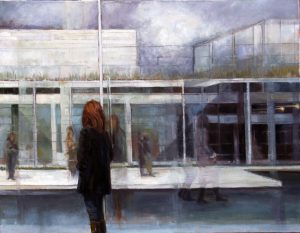 Cathy Abramson’s oil paintings investigate the stories of the city. These representational paintings examine the emotional subtext of change; the connections or estrangement of people in transitional neighborhoods. She sees moments of poetry in the ordinary. Although she paints particular people and scenes, these paintings about daily life in Washington, DC resonate with everyone. Cathy spent two years investigating and painting the neighborhood and people around Kennedy Street, NW. She recorded scenes that are about recent history, change, nostalgia and social struggle; the joys and frustrations of contemporary urban life.
Cathy Abramson’s oil paintings investigate the stories of the city. These representational paintings examine the emotional subtext of change; the connections or estrangement of people in transitional neighborhoods. She sees moments of poetry in the ordinary. Although she paints particular people and scenes, these paintings about daily life in Washington, DC resonate with everyone. Cathy spent two years investigating and painting the neighborhood and people around Kennedy Street, NW. She recorded scenes that are about recent history, change, nostalgia and social struggle; the joys and frustrations of contemporary urban life.
A Conversation with Steve Wanna
A CONVERSATION WITH STEVE WANNA
In the Eternity of an Instant: Mixed Media by Steve Wanna
Margaret W. & Joseph L. Fisher Art Gallery
Schlesinger Concert Hall & Arts Center
Please join us for an Artist Talk – August 17th, 2019 12PM-3PM
How have your personal experiences impacted your art?
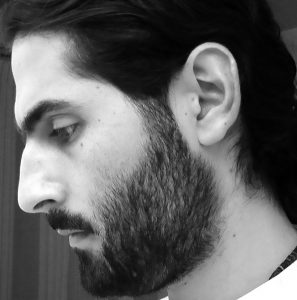 That’s a difficult question to answer for me because I don’t often tie my personal experiences to my work. I immigrated to the U.S. as a teenager and have been straddling two cultures ever since. Yet I don’t feel like I belong fully in either. I suppose this sense of not belonging is pretty common among artists. I’m also a contemplative person by nature and that definitely seeps into my work in big ways. My current worldview is largely informed by science, mathematics and Buddhism. I firmly believe in statistics and coincidence—the business of fate and whatnot makes no sense to me. This has the largest influence on my art by far. A lot of my work has elements of controlled randomness, whether in the decisions surrounding the work, the process of making it or the final result itself.
That’s a difficult question to answer for me because I don’t often tie my personal experiences to my work. I immigrated to the U.S. as a teenager and have been straddling two cultures ever since. Yet I don’t feel like I belong fully in either. I suppose this sense of not belonging is pretty common among artists. I’m also a contemplative person by nature and that definitely seeps into my work in big ways. My current worldview is largely informed by science, mathematics and Buddhism. I firmly believe in statistics and coincidence—the business of fate and whatnot makes no sense to me. This has the largest influence on my art by far. A lot of my work has elements of controlled randomness, whether in the decisions surrounding the work, the process of making it or the final result itself.
Where did you go to school?
I started out taking classes at Northern Virginia Community College when I immigrated here with my family. I transferred to James Madison University to complete my undergraduate and Masters in Music Composition. After that I went on to the University of Maryland to work on my doctorate in Composition with a focus on electronic music, followed by a year-long postdoc at a studio in Paris. That year was very important in that it afforded me a period of incubation and reflection. A lot fell in place for me over the course of that year. I’ve turned to visual and multidisciplinary art recently, and am self-taught—it’s another way I feel like I straddle two cultures, not fully fitting into either. Robert Irwin is another one who’s work and writings resonate with me.
Who were and our your creative influences?
My formal education is in music. My biggest influences for the past decade or so have been Iannis Xenakis and John Cage. They both approached randomness and stochastics from slightly different perspectives. Both worked with processes that removed them from the making of the work, but Xenakis was willing to manipulate the results of his processes to achieve slightly more specific goals, while Cage was willing to completely surrender the results to the processes that yielded them. My aesthetic falls somewhere between the two.
You mentioned that the Myths of Creation series was influenced by images from the Hubble telescope. Can you talk more about how scientific thought has impacted your art?
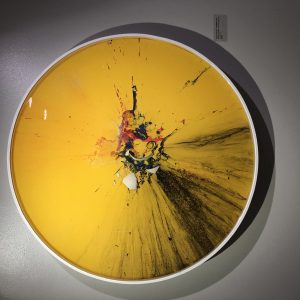 Science has had a huge impact on my thinking, both in art and in life. My work isn’t scientific per se, but definitely inspired by certain principals like systems theory, swarm intelligence, and game theory. I also use technology in some of my work, but there’s nothing particularly unusual about that. When the Hubble images started coming out, I became obsessed. The caption on one simply noted the distance of the exploding star in the image, and it was something in the hundreds of millions of light years away. Aside from being a staggeringly impossible number to fathom, there was something profound and a bit sad and poetic about it: what I was looking at was an event that happened some hundreds of millions of years ago, yet somehow we’re now witnessing it.
Science has had a huge impact on my thinking, both in art and in life. My work isn’t scientific per se, but definitely inspired by certain principals like systems theory, swarm intelligence, and game theory. I also use technology in some of my work, but there’s nothing particularly unusual about that. When the Hubble images started coming out, I became obsessed. The caption on one simply noted the distance of the exploding star in the image, and it was something in the hundreds of millions of light years away. Aside from being a staggeringly impossible number to fathom, there was something profound and a bit sad and poetic about it: what I was looking at was an event that happened some hundreds of millions of years ago, yet somehow we’re now witnessing it.
Describe the process for creating the Myth of Creation pieces.
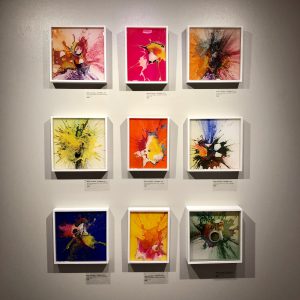 These are pretty involved pieces, and the process has evolved. I start by making the boards and preparing them. Then I make the plaster shells that will hold the pigments. Once all that prep is done, I fill a shell with the various pigments and aggregates. Here I have some measure of control: the order in which I put the material into the shell has some effect on the final result. I’ve built a special enclosure for this step because once I make the drop, the piece has to stay in place until it dries, then I have to spray it with fixative before I can handle it. Because I use powder pigments, I had to come up with a way to spry the fixative indirectly so that it doesn’t blow the powders away. After all that, I add the frame, seal the edges, and pour the resin. The process can take a week or more, yet the actual drop itself happens in a split second. And it’s by far the most exciting part of the process!
These are pretty involved pieces, and the process has evolved. I start by making the boards and preparing them. Then I make the plaster shells that will hold the pigments. Once all that prep is done, I fill a shell with the various pigments and aggregates. Here I have some measure of control: the order in which I put the material into the shell has some effect on the final result. I’ve built a special enclosure for this step because once I make the drop, the piece has to stay in place until it dries, then I have to spray it with fixative before I can handle it. Because I use powder pigments, I had to come up with a way to spry the fixative indirectly so that it doesn’t blow the powders away. After all that, I add the frame, seal the edges, and pour the resin. The process can take a week or more, yet the actual drop itself happens in a split second. And it’s by far the most exciting part of the process!
The series created with synthetic wax – She Who Makes the Moon the Moon is inspired by a poem? Can you talk more about that? How is literature and poetry important to work as an artist?
 A lot of artists find inspiration in literature and poetry. My work is not representational and therefore never a literal (no pun intended) translation of whatever inspired it. I often find inspiration in reading stories or poems and equally in reading scientific articles. I think there are tremendous and fertile sources for the imagination in scientific discovery. That series is inspired by a story entitled “The Distance to the Moon,” from Italo Calvino’s Cosmicomics. Calvino takes modern scientific knowledge, mostly about the formation of the universe, and retroactively creates fantastical stories and myths that work with them in beautiful ways. It pains me when people describe science as cold. The scientific method may be disinterested in how we feel about it, but the creative spark that sets a scientist’s mind on some hypothesis is the same one that every artist and poet feels. It’s a human spark of curiosity about things larger than ourselves that we do not yet understand but might hope to bring forth with a lot of imagination and hard work.
A lot of artists find inspiration in literature and poetry. My work is not representational and therefore never a literal (no pun intended) translation of whatever inspired it. I often find inspiration in reading stories or poems and equally in reading scientific articles. I think there are tremendous and fertile sources for the imagination in scientific discovery. That series is inspired by a story entitled “The Distance to the Moon,” from Italo Calvino’s Cosmicomics. Calvino takes modern scientific knowledge, mostly about the formation of the universe, and retroactively creates fantastical stories and myths that work with them in beautiful ways. It pains me when people describe science as cold. The scientific method may be disinterested in how we feel about it, but the creative spark that sets a scientist’s mind on some hypothesis is the same one that every artist and poet feels. It’s a human spark of curiosity about things larger than ourselves that we do not yet understand but might hope to bring forth with a lot of imagination and hard work.
How has your background in music composition inspired your work?
A lot of my work is concerned with time and processes that center on the passage or capture of time. Time is an integral part of music—sound is a physical phenomenon that is essentially the propagation of vibrations over distance, something that requires time. I find myself creating works that either freeze time through some process, or require time to unfold. I also find myself applying in my visual works a lot of the same aesthetics I’ve developed in my music: an affinity for controlled randomness, an openness to process, a willingness to follow these highly experimental works wherever they need to go.
Describe the process of making “ Come Closer”
This work was the first in a series based in my obsession with shadows. I had a very specific idea in mind and tested a lot of different materials. I played with paper, glass, even tried making some materials from recipes I found. The look I had in mind was that of thin porcelain with light behind it. My partner Tonya suggested having someone make it and that’s what happened. I sent my designs to a ceramic artist and he slip cast them to my specs. The electronics came next. I designed the sounds I wanted using software I’ve used before with other works but I had to get help from my brother who’s an computer engineer in order to realize the works as standalone objects, each with its own microprocessor. We had to work on translating the code to work with the hardware. I then designed the layout of the boards that would go inside the porcelain boxes—they hold a microprocessor, a small speaker, and an LED strip. The small computer runs a program that controls the sound and light. They both ramp up and down at randomly chosen intervals. Each box emits a single pure tone. The combination of all the boxes together creates a complex sound. The piece is quiet and soft, and like many of my works, it’s meant to invite quieted and contemplation. What I find most poetic about it is that because the boxes are independent of each other and are ramping up and down at random intervals, you’ll never hear the same combination of sounds no matter how long you stand there. But the differences in timing are not so huge as to be immediately noticeable. This means the piece effectively looks simple at first glance but you realize there’s actually a lot more to it when you get to know it. This element of discovery is true of a lot of my work. And probably of me, as well…
When people look at your work, what do you hope they get from it? What kind of reaction were you going for when creating this body of work, and what kind of conversation do you hope it provokes?
I hope my work has an impact on people, an impact that is beyond, or rather before words and conversation, the same kind of impact a beautiful sunset might have on one. I’ve always found beauty like that to hit me almost like a physical punch in the gut. For a moment, words fall away and there’s nothing but you and the object and the bare experience. The mind has been foiled by the surprise, arrested for an instant by the experience and impact of beholding that object. Process is something we can talk about, modify, and improve, but impact is beyond words. I guess if someone looks at my work and is clearly impacted by it but has nothing to say that would be okay with me!
What can viewers and art lovers expect from your work in the future?
I’m hoping to move more in the direction of installation work, especially large-scale installations—that’s the kind of work I find most exciting and engaging. I’m continually looking for ways to better present sonic works, so I’ll continue pursuing that. I’ll also likely continue to explore the works and ideas represented in this show.
August 8th 6-8PM Artist Talk with Sunhee Kim Jung
You are invited to join us on Thursday evening August 8th from 6 to 8PM for an engaging and enlightening talk with the Artist Sunhee Kim Jung. Feel free to come out early to avoid traffic. Jung will discuss the two series: The Sanctuary Series in the Passage Gallery and the Camouflage series in the large and spacious Forum Gallery.
This is Sunhee’s 12th solo exhibition of her artistic career which spans three decades. In both of the series, Sunhee uses figures over whelmed by landscapes to address sacrifice, loss and alienation. The paintings while visually accessible and intriguing also lead us to ask personal questions about our views of the subject matter.
Please come to the artist talk to meet the artist and experience her solo exhibition. Please visit Sunhee’s About the Artist page to learn more about her and this exhibit.
June 22nd, 2019 2-4PM Solo Art Reception: Steve Wanna, Sunhee Kim Jung
May 31st 11am – 12PM Coffee & Conversation with Norma Schwartz
Artist Talk: Jonathan Ottke, May 23rd, 2019 6:30 – 8PM
Atist Talk with Jonathan Ottke: May 23rd, 2019: 6:30-8PM.
Jonathan Ottke lives by Lake Braddock in the Washington DC area where he took many of the photographs in this series. He has lived in many places including in Waldenbuch, Germany, Nairobi, Kenya and Vienna, Austria. His travels and his training as a biologist affect his art. He has exhibited in numerous exhibitions in the Washington DC region including Falls Church Arts, Art Enables, and Del Ray Gallery. He has an M.S. in Biology from George Mason University with a focus on environment microbiology and a B.S. in Fine Arts and German from the University of Virginia. “In a Drop of Water” is his first solo exhibition.
These series of photographs of water taken by Lake Braddock focus on the small often overlooked beauty that is in the details of nature. Raindrops falling on a leaf, a blooming flower after a rain, the frozen lake, are all the sources and materials of these photographs.
Jonathan takes inspiration from William Blake’s quote “see a world in a grain of sand and a heaven in a wild flower”.
“With my photography, I observe the world closely around me looking for the beauty in the everyday. I am especially interested in the spiritual implications of materials in art and the way we create the world every time we see it anew. I hope my photography gives people a timeless, universal feeling and shows the otherworldly in the everyday.”
May 4th, 2019 Gallery Reception for Norma Schwartz, Jonathan Ottke and Nataliya Gurshman
You are invited to join us Saturday afternoon for the gallery reception for three outstanding exhibitions at the Rachel M. Schlesinger Concert Hall and Arts Center. The artists will be present between 2 and 4pm to greet the guests and answers questions about their art work.
The shows are currently public and will run through June 9th, 2019.
Gallery Hours are Monday – Friday 10AM – 5PM
The exhibitions are as follows:
shape of memories: sculpture by Norma Schwartz
Margaret W. & Joseph L. Fisher Art Gallery
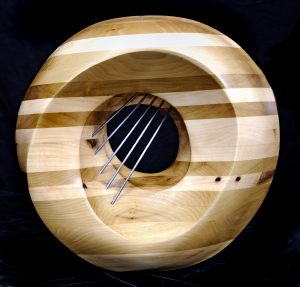
In a Drop of Water: Photographer by Jonathan Ottke
Passage Gallery
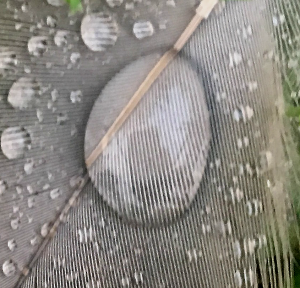
My Russian Soul: Paintings by Nataliya Gurshman
Forum Gallery

April 16th, 2019 6:30-8:30PM Confluence: Two Rivers, One City
During the last week of “Coming to Light, Encaustics by Angela White” and “NOMAD, The Art of Alonzo Davis“, the Schlesinger Art Galleries is hosting a special public presentation of Confluence 2019, the DC region’s annual publication of critical writing on the visual arts on Tuesday evening from 6:30pm The speaker is Phil Hutinet, the publisher of East City Art.
CONFLUENCE: Two Rivers One City Public Presentation
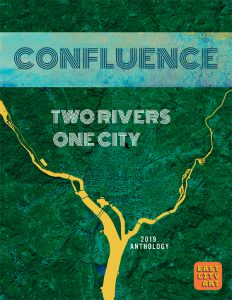 East City Art, DC’s visual arts publication of record, has released its second annual anthology of critical writing titled CONFLUENCE: Two Rivers One City. The 30 essays of the anthology present some of East City Art’s most compelling writing and document the DC region’s most prominent influences on regional visual arts culture.
East City Art, DC’s visual arts publication of record, has released its second annual anthology of critical writing titled CONFLUENCE: Two Rivers One City. The 30 essays of the anthology present some of East City Art’s most compelling writing and document the DC region’s most prominent influences on regional visual arts culture.
The title of the anthology alludes to the confluence of the Potomac and Anacostia rivers which flow through the region affectionately known as the “DMV” (DC, Maryland and Virginia).
CONFLUENCE 2019 offers insight into DC’s art world with in-depth critical writing and full color photographs of work by local, national and international artists displayed at regional galleries, museums and art spaces.
“The dedication of the East City Art writing staff to publish serious art criticism has never been stronger. Articles with ample discussion make ECA an alternative to the condensed and often superficial reviews offered elsewhere of gallery exhibits,” explains Editor-at-Large and Claudia Rousseau, Ph.D.
Publisher Phil Hutinet will present an overview of the reviews in CONFLUENCE 2019 while highlighting examples of work by local artists published in the anthology. During and after the presentation, audience members will have the opportunity to participate in the discussion and ask questions.
Speaker Biography
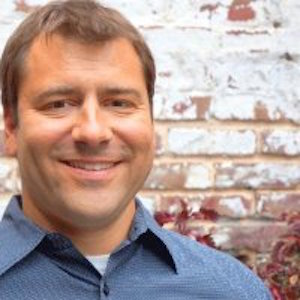 Phil Hutinet, a third generation Capitol Hill resident, is the publisher of East City Art, DC’s Visual Arts publication of record, which he began in 2010. In 2012-2013, his consultancy work east of the river yielded the Anacostia Playhouse, Craig Kraft Studios, the Anacostia Arts Center and the 2012-2013 LUMEN8ANACOSTIA festivals. In 2015, 2018 and 2019 he acted as the Gateway Open Studio Tour coordinator. From 2013-2018, he produced EMULSION, East City Art’s regional juried show and has produced over 150 local exhibitions in his career as a gallery owner and director. Currently, he oversees the ECA Foundation’s Critical Arts Writing and Research Program which produces an annual anthology titled CONFLUENCE: Two Rivers One City. Hutinet has been interviewed by or has made appearances on the BBC, Capital Community News, Euronews, Washingtonian Magazine, Washington City Paper, The Washington Post, WJLA ABC News Channel 7/Channel 8, WTOP and other local, national and international media.”
Phil Hutinet, a third generation Capitol Hill resident, is the publisher of East City Art, DC’s Visual Arts publication of record, which he began in 2010. In 2012-2013, his consultancy work east of the river yielded the Anacostia Playhouse, Craig Kraft Studios, the Anacostia Arts Center and the 2012-2013 LUMEN8ANACOSTIA festivals. In 2015, 2018 and 2019 he acted as the Gateway Open Studio Tour coordinator. From 2013-2018, he produced EMULSION, East City Art’s regional juried show and has produced over 150 local exhibitions in his career as a gallery owner and director. Currently, he oversees the ECA Foundation’s Critical Arts Writing and Research Program which produces an annual anthology titled CONFLUENCE: Two Rivers One City. Hutinet has been interviewed by or has made appearances on the BBC, Capital Community News, Euronews, Washingtonian Magazine, Washington City Paper, The Washington Post, WJLA ABC News Channel 7/Channel 8, WTOP and other local, national and international media.”
March 16th, 2019 2-4PM: Artist Receptions for Alonzo Davis and Angela White
We are very pleased to announce our early spring exhibitions and invite you to the opening receptions. We will have two new solo exhibitions opening on March 9th, 2019, Saturday afternoon 2-4PM.
NOMAD: The Art of Alonzo Davis
Forum Gallery and the Margaret W. & Joseph L. Fisher Art Gallery
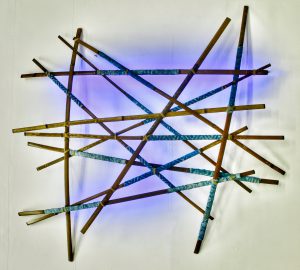 We pleased to present work from two of Alonzo Davis’s recent series, the Navigation Series and the Migrant Series. The Navigation Series is inspired by Alonzo’s long-time fascination with Micronesian navigation stick charts. Once used by the Marshall Islanders of Micronesia, the charts, studies of Pacific swell patterns and island locations, helped mariners navigate the waters in and around the region by canoe. The “Migrant Series” is a body of works that express our need for national and world concern of peoples having to leave their homeland because of inhumane conditions.The work in the series are approximately 14″w x 16″h x 5″d; each containing encaustic boats made of bamboo on a mixed media collage painting, with encaustic wax on board with burned and painted bamboo.
We pleased to present work from two of Alonzo Davis’s recent series, the Navigation Series and the Migrant Series. The Navigation Series is inspired by Alonzo’s long-time fascination with Micronesian navigation stick charts. Once used by the Marshall Islanders of Micronesia, the charts, studies of Pacific swell patterns and island locations, helped mariners navigate the waters in and around the region by canoe. The “Migrant Series” is a body of works that express our need for national and world concern of peoples having to leave their homeland because of inhumane conditions.The work in the series are approximately 14″w x 16″h x 5″d; each containing encaustic boats made of bamboo on a mixed media collage painting, with encaustic wax on board with burned and painted bamboo.
To learn more about Alonzo’s work, visit his About the Artist page.
COMING TO LIGHT: The Encaustics of Angela White
Passage Gallery
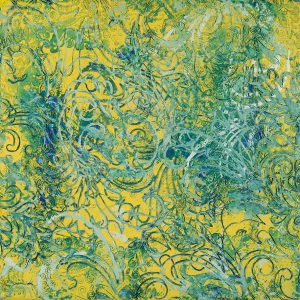 Angela White is a fine artist inspired by physical, spiritual and emotional memories that create the visual depth and density of her work. Abstracts and seascapes compose the majority of her compositions. Natural and sensual materials such as oils and encaustic paint allow the blending of edges to create visual depth. By superimposing layers of media, the varied themes and processes of her work are exposed.
Angela White is a fine artist inspired by physical, spiritual and emotional memories that create the visual depth and density of her work. Abstracts and seascapes compose the majority of her compositions. Natural and sensual materials such as oils and encaustic paint allow the blending of edges to create visual depth. By superimposing layers of media, the varied themes and processes of her work are exposed.
To learn more about Angela, please visit her About the Artist Page.
